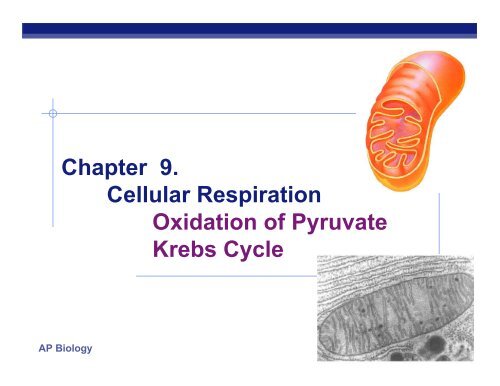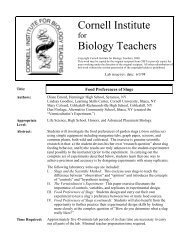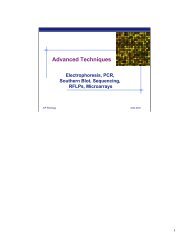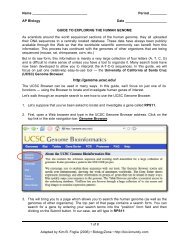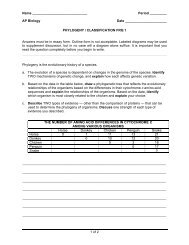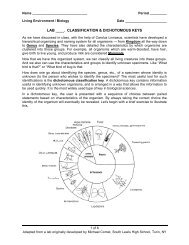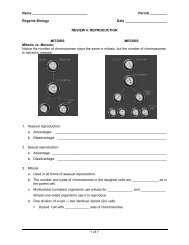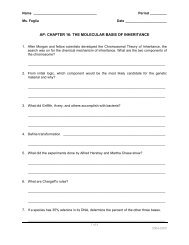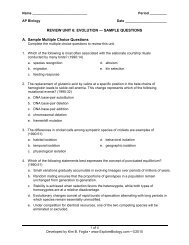Oxidation of Pyruvate & Krebs Cycle - Explore Biology
Oxidation of Pyruvate & Krebs Cycle - Explore Biology
Oxidation of Pyruvate & Krebs Cycle - Explore Biology
You also want an ePaper? Increase the reach of your titles
YUMPU automatically turns print PDFs into web optimized ePapers that Google loves.
Chapter 9.Cellular Respiration<strong>Oxidation</strong> <strong>of</strong> <strong>Pyruvate</strong><strong>Krebs</strong> <strong>Cycle</strong>AP <strong>Biology</strong>2005-2006
Glycolysis is only the start Glycolysisglucose → → → → → pyruvate6C2x 3C <strong>Pyruvate</strong> has more energy to yield 3 more C to strip <strong>of</strong>f (to oxidize) if O 2 is available, pyruvate enters mitochondria enzymes <strong>of</strong> <strong>Krebs</strong> cycle complete oxidation <strong>of</strong>sugar to CO 2AP <strong>Biology</strong>pyruvate → → → → → → CO 23C1C2005-2006
Cellular respirationAP <strong>Biology</strong>2005-2006
What’s the point?ATPThe Point is to Make ATP!AP <strong>Biology</strong>2005-2006
<strong>Oxidation</strong> <strong>of</strong> pyruvate <strong>Pyruvate</strong> enters mitochondria[ ]2x pyruvate → → → acetyl CoA + CO 23C 2C 1CAP <strong>Biology</strong>3 step oxidation processreleases 1 CO 2 (count the carbons!)reduces NAD → NADH (stores energy)produces acetyl CoA Acetyl CoA enters <strong>Krebs</strong> cycleNADwhere does CO 2 go?NADHWaiting toexhale?2005-2006
<strong>Pyruvate</strong> oxidized to Acetyl CoAreductionoxidationYield = 2C sugar + CO 2 + NADHAP <strong>Biology</strong>2005-2006
<strong>Krebs</strong> cycle1937 | 1953AP <strong>Biology</strong> aka Citric Acid <strong>Cycle</strong> in mitochondrial matrix 8 step pathway each catalyzed by specific enzyme step-wise catabolism <strong>of</strong> 6C citrate molecule Evolved later than glycolysis does that make evolutionary sense? bacteria →3.5 billion years ago (glycolysis) free O 2 →2.7 billion years ago (photosynthesis) eukaryotes →1.5 billion years ago (aerobicrespiration (organelles)Hans <strong>Krebs</strong>1900-19812005-2006
Count the carbons!pyruvate3C4C2Cacetyl CoA6CcitrateThis happenstwice for eachglucosemolecule4C4Cx2oxidation<strong>of</strong> sugars6C5CCO 2AP <strong>Biology</strong>4C4CCO 22005-2006
Count the electron carriers!pyruvate3C2Cacetyl CoANADH4C6CcitrateThis happenstwice for eachglucosemolecule4C4Cx2reduction<strong>of</strong> electroncarriers6C5CCO 2NADHAP <strong>Biology</strong>FADH 24CATP4CCO 2NADH2005-2006
Whassup?So we fullyoxidizedglucoseC 6 H 12 O 6↓CO 2& ended upwith 4 ATP!AP <strong>Biology</strong>What’s thePoint?2005-2006
NADH & FADH 2 <strong>Krebs</strong> cycleproduces largequantities <strong>of</strong>electron carriers NADH FADH 2 stored energy! go to ETCAP <strong>Biology</strong>What’s soimportantabout NADH?2005-2006
Energy accounting <strong>of</strong> <strong>Krebs</strong> cycle4 NAD + 1 FAD 4 NADH + 1 FADH2]22x [pyruvate → → → → → → → → → CO3C3x 1C1 ADP 1 ATP Net gain = 2 ATP= 8 NADH + 2 FADH 2AP <strong>Biology</strong>2005-2006
So why the <strong>Krebs</strong> cycle? If the yield is only 2 ATP, then why? value <strong>of</strong> NADH & FADH 2 electron carriers reduced molecules store energy! to be used in the Electron Transport ChainAP <strong>Biology</strong>2005-2006
What’s the point?ATPThe Point is to Make ATP!AP <strong>Biology</strong>2005-2006
Any Questions??AP <strong>Biology</strong>2005-2006


